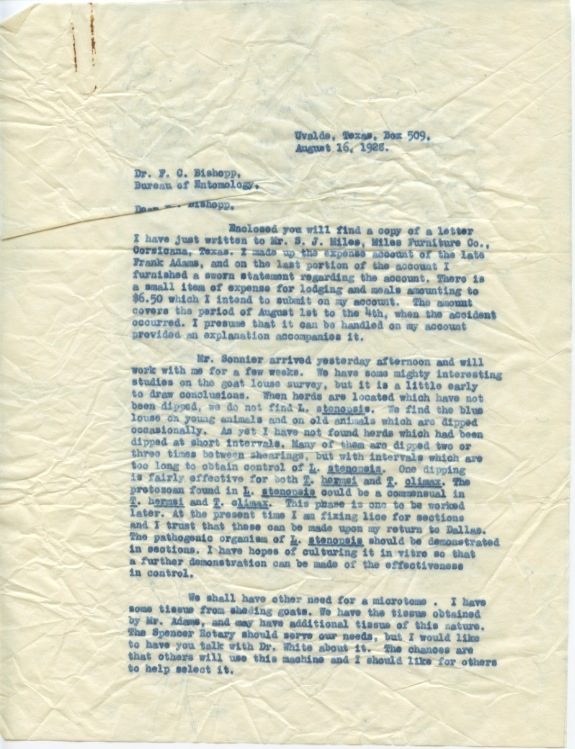Walter and Ina are together now, and therefore not writing letters to each other, so I’ll be posting some work- and family-related correspondence to and from them during this period.
Uvalde, Texas, Box 509
August 16, 1928.
Dr. F.C. Bishopp,
Bureau of Entomology.
Dear Dr. Bishopp,
Enclosed you will find a copy of a letter I have just written to Mr. S.J. Miles, Miles Furniture Co., Corsicana, Texas. I made up the expense account of the late Frank Adams, and on the last portion of the account I furnished a sworn statement regarding the account. There is a small item of expense for lodging and meals amounting to $6.50 which I intend to submit on my account. The amount covers the period of August 1st to the 4th, when the accident occurred. I presume that it can be handled on my account provided an explanation accompanies it.
Mr. Sonnier arrived yesterday afternoon and will work with me for a few weeks. We have some mighty interesting studies on the goat louse survey, but it is a little early to draw conclusions. When herds are located which have not been dipped, we do not find L. stenopsis. We find the blue louse on young animals and on old animals which are dipped occasionally. As yet I have not found herds which had been dipped at short intervals. Many of them are dipped two or three times between shearings, but with intervals which are too long to obtain control of L. stenopsis. One dipping is fairly effective for both T. hermsi and T. climax. The protozoan found in L. stenopsis could be a commensual in T. hermsi and T. climax. This phase is one to be worked later. At the present time I am fixing lice for sections and I trust that these can be made upon my return to Dallas. The pathogenic organism of L. stenopsis should be demonstrated in sections. I have hopes of culturing it in vitro so that a further demonstration can be made of the effectiveness in control.
We shall have other need for a microtome. I have some tissue from shedding goats. We have the tissue obtained by Mr. Adams, and may have additional tissue of this nature. The Spencer Rotary should serve our needs, but I would like to have you talk with Dr. White about it. The chances are that others will use this machine and I should like for others to help select it.
At the present time the microtome and an extra knife should be ordered. I shall need a small oven, but we can get this when I return to Dallas. The large one cannot be regulated satisfactorily, but can be used for infiltrating. The smaller one would be needed for culturing.
Yesterday I wired you regarding Mr. Roberts. I do not want you to think that I am interfering with your business. I have no desire to do so. It occurred that Mr. Roberts might be in Uvalde until he can be appointed in the grade of assistant. Mr. Roberts was reared in this section and in a letter to me he expressed a desire to be in Uvalde. He would work here for the amount you could pay him. I would like to see Mr. Roberts in our service if it is at all possible to keep him. My interest in the thing is for the good of the service, whether it is a question of keeping a good man or discharging a poor one. I know that Mr. Roberts could get the tissue which we wanted Mr. Adams to obtain. He could continue the experiments on the amount of tissue used by larvae in their development. Mr. Adams had a method of extracting fluid from larvae with a saline and he then diluted this to a normal salt solution. With this he was making some injections to see if immunity could be established. He was testing for toxic effects also. It might be well to reserve the tests for toxicity until the B.A.I. can cooperate. Mr. Parman favors such cooperation on the toxicity tests. Mr. Roberts would have plenty to do in getting the tissue and in studying the amount of tissue consumed.
Very truly yours,
Walter E. Dove
Associate Entomologist.

